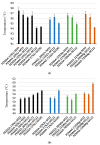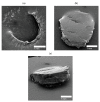Self-Healability of Poly(Ethylene-co-Methacrylic Acid): Effect of Ionic Content and Neutralization
- PMID: 36080647
- PMCID: PMC9460424
- DOI: 10.3390/polym14173575
Self-Healability of Poly(Ethylene-co-Methacrylic Acid): Effect of Ionic Content and Neutralization
Abstract
Self-healing polymers such as poly(ethylene-co-methacrylic acid) ionomers (PEMAA) can heal themselves immediately after a projectile puncture which in turn lowers environmental pollution from replacement. In this study, the thermal-mechanical properties and self-healing response of a library of 15 PEMAA copolymers were studied to understand the effects of the ionic content (Li, Na, Zn, Mg) and neutralization percentage (13 to 78%) on the results. Differential scanning calorimetry (DSC), dynamic mechanical analysis (DMA), and tensile testing were used to study the thermo-mechanical properties of PEMAA copolymers while the self-healing response was studied using the projectile test. Puncture sites were observed using scanning electron microscopy (SEM) and the healing efficiency was quantitatively measured using the water leakage test. Five different self-healing responses were observed and correlated to ionic content and neutralization. At high neutralization, divalent neutralizing ions (Zn and Mg) that have stronger ionic interactions exhibited brittle responses during projectile testing. PEMAA samples neutralized with Mg and Li at low concentrations had a higher healing efficiency than PEMAA samples neutralized with Zn and Na at low neutralization. The PEMAA copolymers with higher tensile stress and two distinct peaks in the graph of loss factor versus temperature that indicate the presence of sufficient ionic aggregate clusters had improved healing efficiency. By increasing the neutralization percentage from 20% to 70%, the tensile strength and modulus of the samples increased and their self-healability generally increased. Among the investigated samples, the copolymer with ~50% neutralization by Li salt showed the highest healing efficiency (100%). Overall, the strength and elastic response required for successful self-healing responses in PEMAA copolymers are shown to be governed by the choice of ion and the amount of neutralization.
Keywords: ionomer; mechanical properties; poly(ethylene-co-methacrylic acid); projectile test; self-healing efficiency; self-healing polymers; thermal properties.
Conflict of interest statement
The authors declare no conflict of interest.
Figures



















References
-
- Blaiszik B.J., Kramer S.L.B., Olugebefola S.C., Moore J.S., Sottos N.R., White S.R. Self-Healing Polymers and Composites. Annu. Rev. Mater. Res. 2010;40:179–211. doi: 10.1146/annurev-matsci-070909-104532. - DOI
-
- Kumar Banshiwal J., Nath Tripathi D. Functional Materials. IntechOpen; London, UK: 2019. Self-Healing Polymer Composites for Structural Application. - DOI
-
- Reddy K.R., El-Zein A., Airey D.W., Alonso-Marroquin F., Schubel P., Manalo A. Self-healing polymers: Synthesis methods and applications. Nano-Struct. Nano-Objects. 2020;23:100500. doi: 10.1016/j.nanoso.2020.100500. - DOI
LinkOut - more resources
Full Text Sources

